Ukrainian and Chinese air defense systems based on air combat missiles with a semi-active radar guidance system
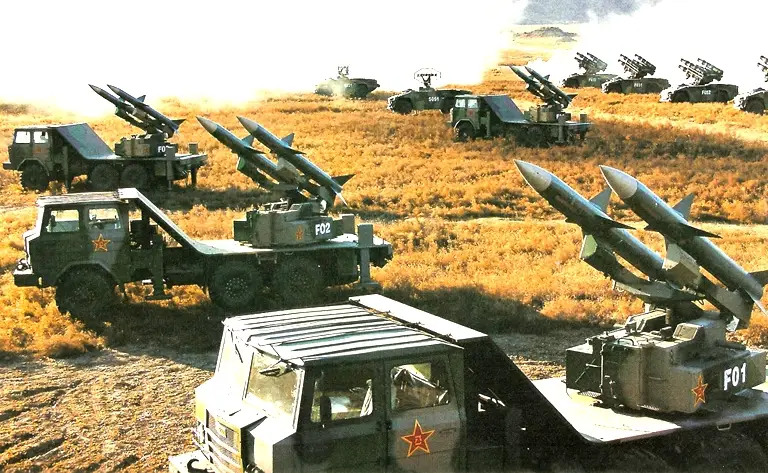
Most common types aviation missiles with a semi-active radar guidance system today are the AIM-7 Sparrow missile, as well as their Italian and Chinese clones.
In a publication dedicated to Ukrainian mobile air defense systems FrankenSAM, which used the AIM-7 Sparrow and RIM-7 Sea Sparrow missiles, the positive and negative qualities of such air defense systems, as well as the prospects for their use, were examined in detail. However, in addition to the numerous Sparrow family of missiles, there are other semi-active radar-guided air-to-air missiles in the world, on the basis of which attempts have also been made to create land-based air defense systems.
Before moving on to the story, for a better understanding, let’s take a closer look at the method of using aircraft-based air combat guided missiles with a semi-active radar homing head (PARL homing head), which differ in firing range, weight and dimensions, but have a common operating principle.
On medium-range missiles (for example, on the Soviet R-27R or the American AIM-7 Sparrow), PARL seekers are used in combination with INS and radio correction. After detecting a target using a radar and launching such a missile, the need remains to illuminate the target with the interceptor's radar until the missile hits it. This guidance method makes it possible to increase the firing range many times over compared to missiles equipped with an infrared seeker. At the same time, after launching a rocket with a PARL seeker, the carrier aircraft is severely constrained in maneuver.
During the Cold War, the United States evolved the Sparrow family of missiles, all modifications of which have the same attachment points, similar geometric dimensions and weight, which allows them to be suspended on the same carrier aircraft.
Another American missile with a PARL seeker was the AIM-4 Falcon. However, the Falcon missile launcher was significantly inferior in characteristics to the Sparrow and was used very limitedly.
Also in the United States, from 1965 to 1967, more than 800 AIM-9C Sidewinder missiles were produced, which were also aimed at a high-frequency signal reflected from the target. However, due to the short firing range, the Sidewinder radar version did not have any advantages over modifications with an IR seeker, and therefore did not become widespread and was not used for long. In the 1970s, most of the AIM-9S missiles were equipped with an IR seeker.
While the Americans tried to unify their air combat missiles for various carriers, the USSR, on the contrary, often created its own radar-guided missile for each new interceptor. This was largely due to the fact that the radars of domestic fighters and the seekers of Soviet missiles were inferior to their American counterparts in terms of illumination potential and receiver sensitivity.
Thus, the Tu-128 loitering interceptor carried four very large missiles R-4R (with PARL seeker) and R-4T (with IR seeker) more than 5,5 m long and weighing more than 500 kg. With such weight and dimensions, the firing range did not exceed 25 km.
The Su-8, Yak-98P and Su-11 interceptors were armed with R-28 and R-15 missiles. The latest version of the R-98M1, put into service in 1975, had a length of 4,4 m, a launch weight of 227 kg and a launch range of up to 21 km.
For the MiG-25P interceptor, the R-40R (with PARL seeker) and R-40T (with IR seeker) missiles were created. The R-40R missile weighed 455 kg, had a length of more than 6,7 m and a firing range of up to 30 km.
To provide the ability for front-line MiG-21 and MiG-23 fighters to attack visually unobservable targets detected by radar, the R-3M missile launcher was mass-produced. However, the capabilities of this rocket were very modest. With a mass of 84 kg and a length of 3,12 m, it was possible to hit an air target at a distance of up to 8 km.
Simultaneously with the testing of the MiG-23 fighter, the R-23R (with PARL seeker) and R-23T (with IR seeker) missiles were developed specifically for it. When creating the R-23R missile launcher, its weight was reduced to 222 kg, and its characteristics were brought closer to the American AIM-7E Sparrow.
In the early 1980s, the improved R-23R missile with a launch weight of 23 kg and a length of 24 m was introduced into the armament of the MiG-245ML and MiG-4,5P. The firing range of the R-24R in the front hemisphere reached 50 km.
For the MiG-29 and Su-27 fighters, production of the R-1984R and R-27T missile launchers began in 27. The R-27R missile with a semi-active seeker is capable of locking onto a target with an EPR of 3 m² at a distance of 22 km. Launch range – up to 60 km. Weight more than 253 kg. The weight of the warhead is 39 kg. Length – 4,8 m.
The adoption of the R-27 family of missile launchers made it possible to eliminate the gap with the United States in medium-range air-to-air missiles and to more fully unleash the potential of Soviet 4th generation fighters. The Soviet R-27R missile significantly surpassed the American AIM-7F missile in its main parameters. The modular principle inherent in the design of the R-27 made it possible to create modifications of missiles equipped with various seekers, with increased energy capabilities and an increased firing range.
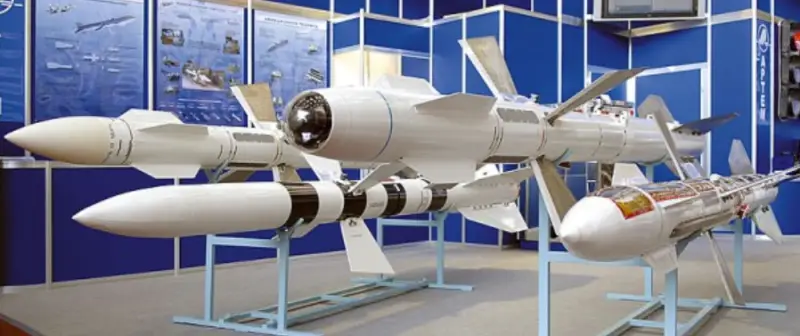
R-27 missiles with different guidance systems have unified components: control and power supply units, load-bearing surfaces and rudders, as well as warheads. Each of the modifications can be equipped with standardized engines of conventional (R-27R and R-27T) and high-energy (R-27ER and R-27ET) engines and guidance systems based on infrared seeker, as well as semi-active and passive radar seeker.
The R-27ER missile, when attacking a target on a collision course, has a firing range of 80 km. Its launch weight is 350 kg, length – 4 mm. The diameter of the engine compartment has been increased from 775 to 230 mm.
R-27P missiles with a passive radar homing head are designed against enemy aircraft with operating radars that cause active jamming. The oncoming acquisition range of the AN/APG-63(V) emitting radar of the F-15C fighter exceeds 180 km. The firing range for the R-27P1 modification is 110 km.
Chinese air defense systems HQ-61, HQ-64, HQ-6D and HQ-6A
In the late 1970s, the PLA Air Force had at its disposal a single type of close-in missile, the PL-2. This missile, put into service in 1967, was a clone of the Soviet R-3S (K-13), which in turn was copied from the American AIM-9B Sidewinder missile.
In 1982, the PL-5 air-to-air missile entered service, which was an improved version of the PL-2. But this rocket did not have a significant advantage over the previous model, and its production lasted only 5 years.
After the J-8 interceptor was put into service, the question arose about equipping it with missiles capable of destroying unobservable aerial targets in the dark and in difficult weather conditions. The existing missile launchers with the PL-2 and PL-5 TGS did not provide this, and attempts to pirate the American AIM-7E Sparrow medium-range missiles were unsuccessful. China received the first samples of the AIM-7 missile in the early 1970s from Vietnam. However, due to the weakness of the Chinese electronics industry and the inability to recreate the solid fuel recipe, it was not possible to reproduce this American rocket.
After Deputy Premier of the State Council of the People's Republic of China Deng Xiaoping visited the United States in January 1979, where he met with President Jimmy Carter, allied relations were established between Beijing and Washington. The main reason for the rapprochement between China and the United States was a common hostile attitude towards the USSR.
In the new round of the arms race, promoted in the early 1980s, China was in dire need of a modern weapons, necessary for the radical modernization of the PLA, and Western countries provided their own samples within the framework of military-technical cooperation.
First of all, Chinese specialists were interested in modern radar technology, communications and automated combat control systems, aircraft engines, anti-tank systems, guided anti-ship missiles and air combat missiles.
To compensate for the lag in the field of aviation weapons, in the late 1980s China established licensed production of close-in missiles: the French R.550 Magic and the Israeli Python-3.
The Chinese J-8II interceptors were armed with the PL-11 missile, created on the basis of the Italian Aspide Mk.1 missile launcher with a STEAM seeker. The first batch of PL-11 missiles were assembled from Italian components.
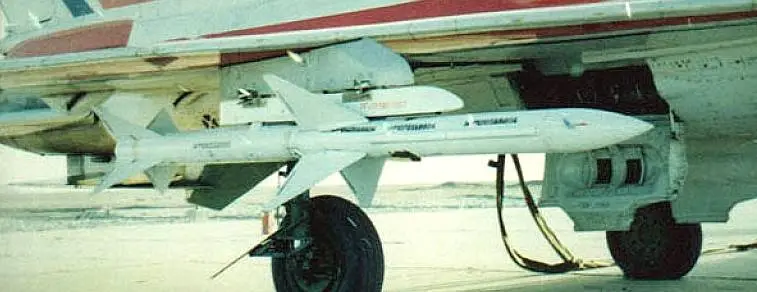
Chinese medium-range missile defense PL-11
With a launch weight of 230 kg, the length of the rocket was 3 mm, the diameter was 690 mm. The PL-210 medium-range missile is equipped with a fragmentation warhead weighing 11 kg. Firing range – up to 33 km.
After the events in Tiananmen Square in June 1989, defense cooperation between the West and the PRC ceased. Up to this point, China has managed to obtain enough parts to assemble just over 100 PL-11 missiles. In the early 1990s, the PL-11 missile launcher was introduced into the armament of the J-8II combat interceptor fighters.
In the second half of the 1990s, China managed to establish independent production of PL-11A missiles with inertial guidance in the initial and mid-flight phases and radar illumination only in the final phase, which made it possible to use them as part of land and sea air defense systems.
In the late 1980s, about 80 HQ-2 medium-range air defense systems (the Chinese version of the Soviet S-75) with HQ-2 liquid-propelled anti-aircraft missiles, which could fight enemy air at medium and high altitudes, were deployed on the territory of the People's Republic of China. Covering Chinese troops and facilities from low-altitude air strikes was then entrusted mainly to 12,7–14,5 mm anti-aircraft machine guns and 37–57 mm artillery machine guns, as well as partly to the HN-5 MANPADS (a Chinese pirated copy of the Strela- 2M").
All these air defense systems were ineffective against Soviet front-line Su-24 bombers, capable of making long-term attacks at low altitude. Of particular concern to the Chinese leadership was the fact that Beijing was within reach of the Su-24, which, in the event of a deterioration in Sino-Soviet relations, could be based at airfields in Mongolia.
Unlike the USSR, the PRC did not have facility-based or military air defense systems with solid-fuel missiles, such as the S-125 and Kub. Due to the urgent need of the PLA for a low-altitude facility complex, in the early 1990s the HQ-61 air defense system was created in China, for which they adapted missile defense systems based on the Italian medium-range aviation missile Aspide Mk. 1.
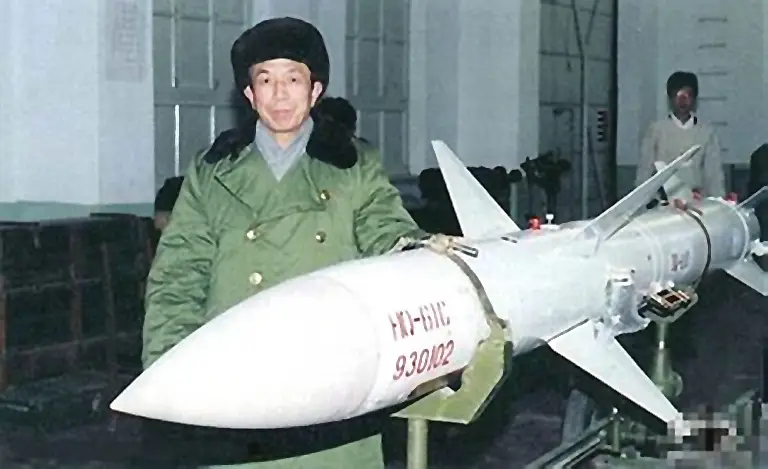
When designing the HQ-61, Chinese specialists from the Shanghai Institute of Science and Technology largely repeated the path previously taken when creating the Italian Spada air defense system. But the characteristics of the Chinese complex turned out to be more modest: the firing range is up to 10 km, the interception altitude is from 25 to 8 m.
To detect air targets, the division was provided with a Type 571 all-round radar; target tracking and missile guidance were carried out by a very simple station with a parabolic antenna and a television-optical sight. The anti-aircraft division included: five SPUs, a detection radar, a guidance station and vans with diesel power generators.
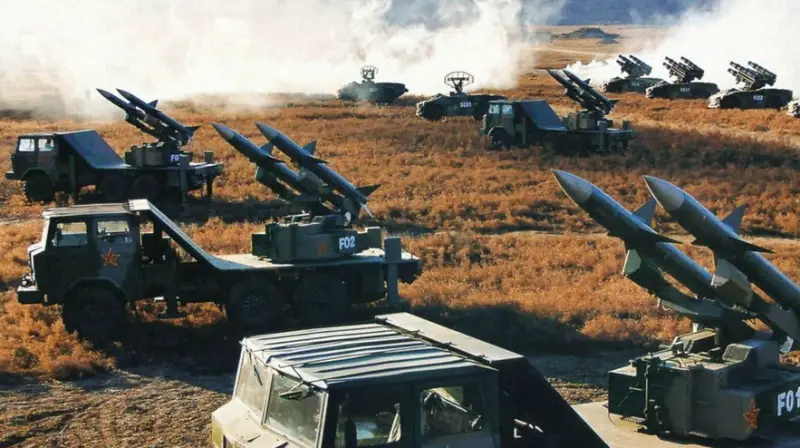
Self-propelled SAM launchers HQ-61
The mobile launcher, made on the basis of a three-axle off-road truck, contained two ready-to-use missiles.
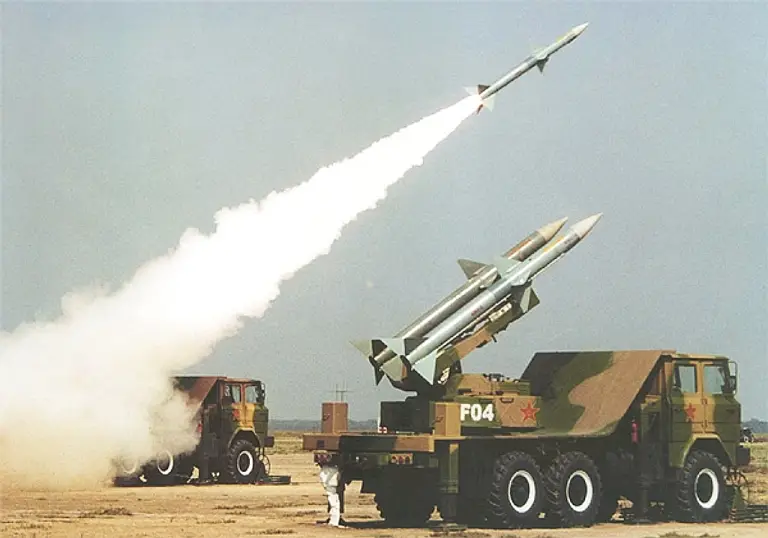
In addition to the land complex with launchers on the chassis of a three-axle 5-ton truck, a ship version of the HQ-61B air defense system was also created.
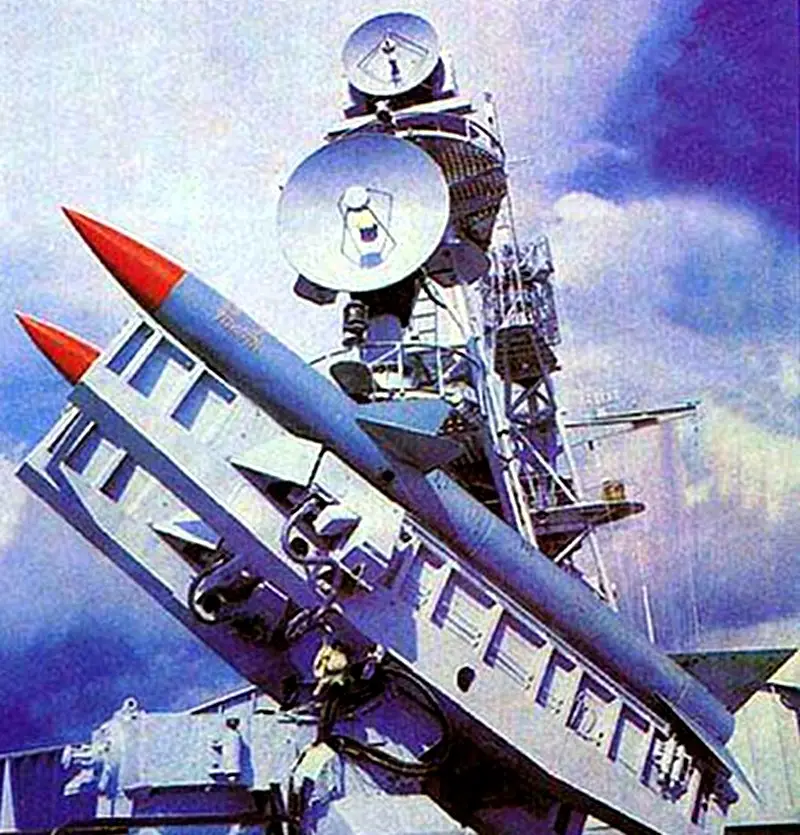
Two Type 61K frigates were armed with HQ-053B complexes. Each ship had two twin beam-type launchers and two anti-aircraft missile guidance stations. These ships were taken out of service in the 1990s.
Currently, one Type 053K frigate with missile launcher mock-ups is on display at the Qingdao Naval Museum.
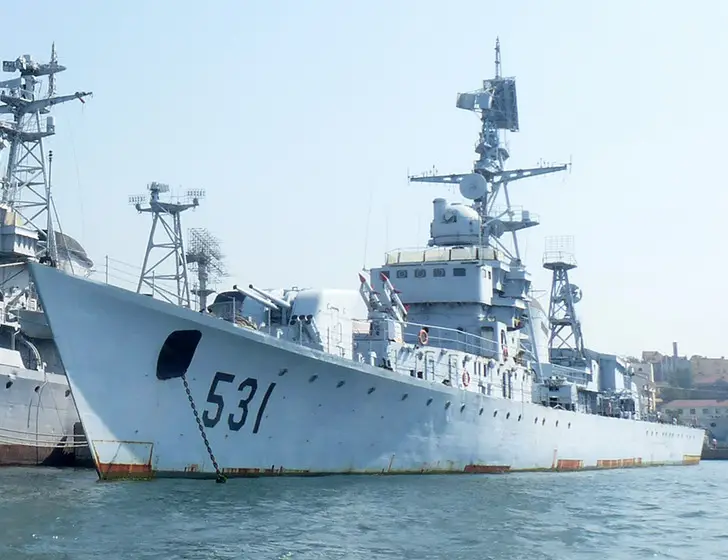
As of today, all land and sea HQ-61 air defense systems have been removed from service. During trial operation, complexes of this type demonstrated low reliability. A primitive guidance station accompanied only by a television-optical sighting device did not provide operation in the dark and in poor visibility conditions. For missiles of this size and mass, the firing range is considered short.
The experience of using the low-volume HQ-61 air defense system made it possible to identify its shortcomings, accumulate experience and develop requirements for a new generation complex. This became possible after, in the second half of the 1990s, the Chinese industry managed to master the independent production of a clone of the Italian Aspid, and the LY-60 missile defense system was created for launching from a land launch vehicle.
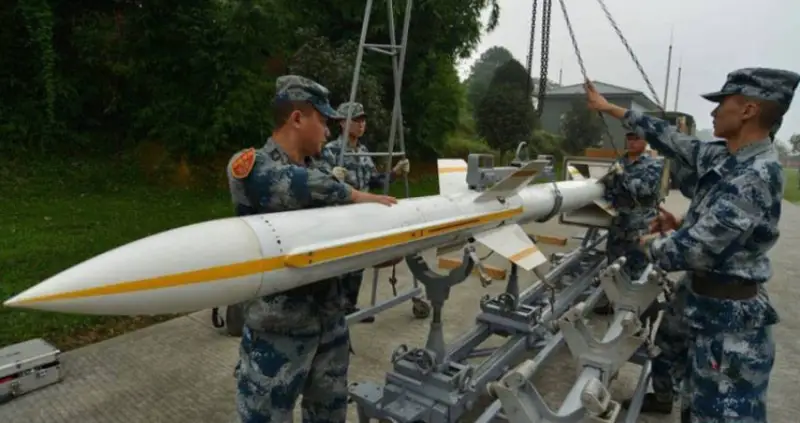
Chinese military personnel with a LY-60 missile
The characteristics of the LY-60 compared to the missiles used as part of the HQ-61 air defense system have been improved. Despite the fact that the LY-60 missile has become 10 kg lighter (launch weight 220 kg), the inclined firing range reaches 15 km. The maximum rocket speed is up to 1 m/s.
Currently, LY-60 missiles are used as part of low-altitude mobile air defense systems HQ-64, HQ-6D and HQ-6A.
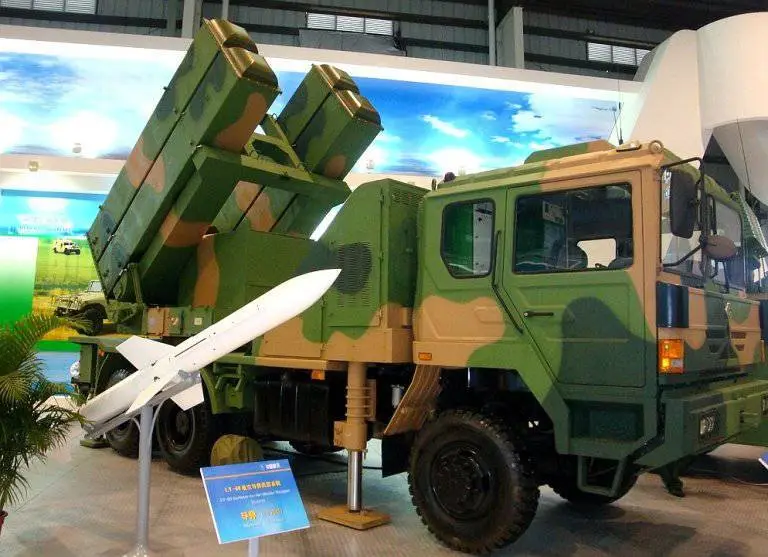
SPU SAM HQ-64 and mockup SAM LY-60
The HQ-64 (HQ-6) mobile anti-aircraft missile system was put into service in 2001. At the SPU, the missiles are placed in closed transport and launch containers, and the number of missiles ready for use has been increased from two to four.
Thanks to the introduction of SNR with combined target tracking (radar channel + optoelectronic system), it became possible to fire in conditions of poor visual visibility.
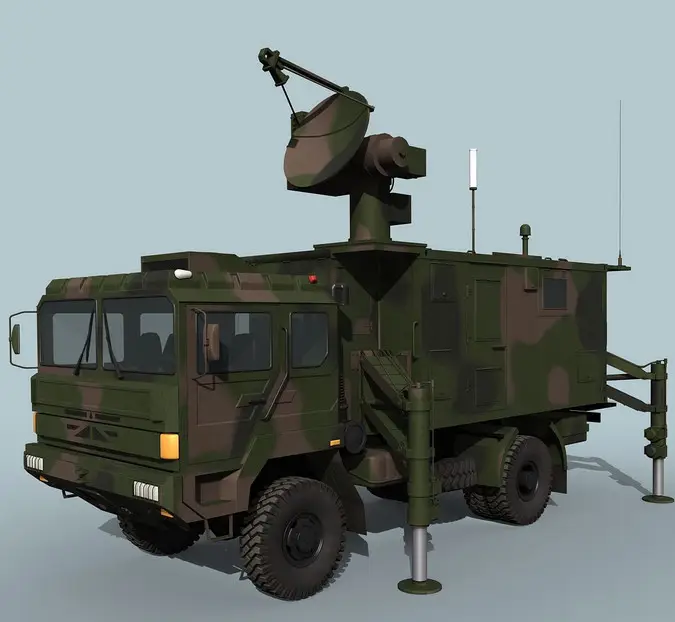
HQ-64 anti-aircraft missile guidance station
Approximately in 2010, deliveries of improved HQ-6D air defense systems with missiles began, the flight speed of which was increased to 1 m/s and the range to 350 km.
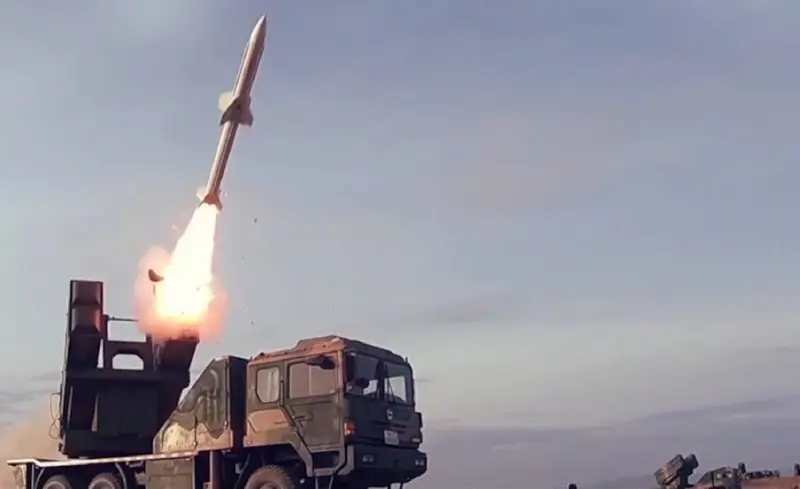
Chinese sources claim that this modification can be integrated into the control system of the HQ-9B long-range air defense system. Thanks to the introduction of new microprocessors, the speed of information processing and the number of target channels have been increased.
Part of the HQ-6D air defense system has been brought to the level of HQ-6A (artillery). At the same time, a 30-mm seven-barrel anti-aircraft artillery mount Toure 730 with a radar-optical guidance system, created on the basis of the Dutch anti-aircraft artillery complex Goalkeeper, was installed on the same platform with the equipment of the missile guidance station, after which the anti-aircraft missile system became a missile and artillery system.
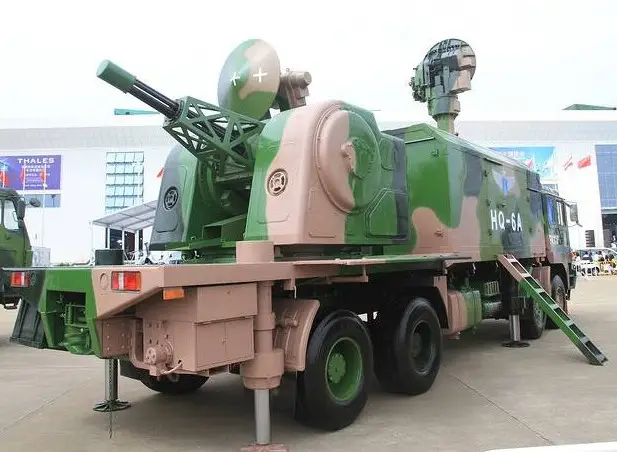
HQ-6A air defense system guidance station with 30-mm Tour 730 anti-aircraft artillery mount
The introduction of a rapid-firing anti-aircraft artillery mount into the air defense system increases the ability to destroy low-altitude air targets and its survivability. According to reference data, at least 20 HQ-6D/6A air defense systems are on combat duty as part of the Chinese air defense system.
Ukrainian air defense system "Dnepr"
For a long period of time, the Ukrainian senior military-political leadership did not pay due attention to the development of anti-aircraft missile forces, relying on arsenals inherited from the USSR. After the division of the Soviet inheritance, independent Ukraine received huge reserves of equipment and weapons, which for some time seemed inexhaustible.
But soon the number of on-site air defense systems deployed on Ukrainian territory decreased many times over. At the end of the 1990s, all medium-range S-75 systems were decommissioned, most of the low-altitude S-125s were disposed of, and the most recent S-125M1s were put into reserve. It is known that several overhauled S-125M1 complexes sailed to countries with hot climates. In 2016, the last division of the long-range S-200VM was removed from combat duty. Due to the shortage of operational medium- and long-range air defense systems, the Buk-M1 and S-300V1 military air defense systems were transferred to the air defense missile forces carrying out object-based air defense.
In the 300st century, the basis of the ground segment of Ukrainian air defense was the S-1PT/PS and Buk-M1980 air defense systems, built in the 25s. The service life of these complexes was determined to be 300 years, and the latest S-1PS and Buk-M1990 available in Ukraine were produced in 15. For approximately the first 2010 years after Kiev received “independence,” the maintenance of the newest complexes in operational condition was mainly due to the “cannibalism” of the anti-aircraft systems in storage. However, there were not enough used parts and components, and by 15, 20–XNUMX divisions could be on combat duty.
The Ukroboromprom enterprise tried to implement a program to extend the life cycle of Soviet-made air defense systems, and in this direction it was possible to achieve some success. But it was quite obvious to specialists that in the absence of production capacity in Ukraine to produce missiles for the S-300PS and Buk-M1, it would not be possible to maintain these systems in working condition for a long time.
In 2015, the Ukrainian government issued a decree on the start of work on the Dnepr medium-range anti-aircraft missile system, which envisaged the use of anti-aircraft missiles created on the basis of the R-27 aircraft guided missiles. In parallel with the start of work on the Dnepr air defense system, Ukraine proposed that Poland create a joint R-27ADS (Air Defense System) air defense system and bear part of the costs.
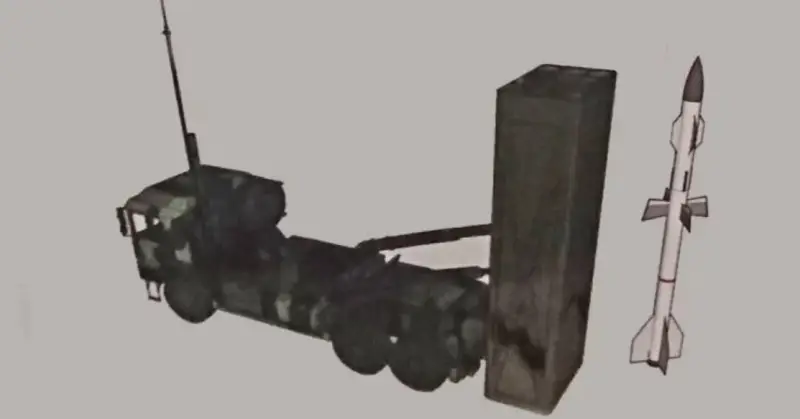
Estimated appearance of the R-27ADS air defense system launcher
For the new Ukrainian air defense system, the Zaporozhye enterprise Research and Production Complex "Iskra" (NPK "Iskra") began creating a multifunctional radar station with phased array, capable of searching and illuminating targets for missile guidance.
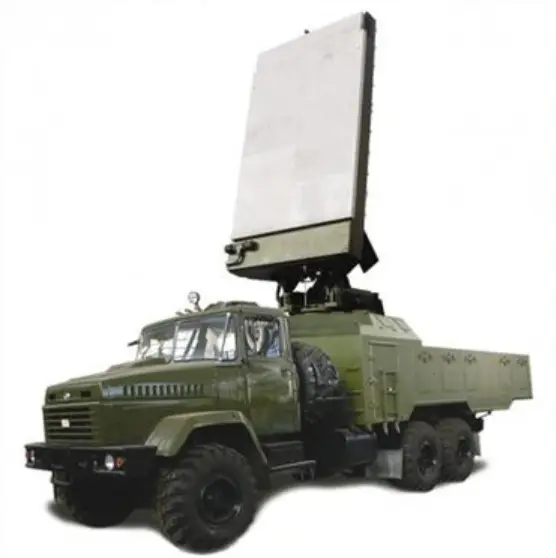
According to advertising data, the radar on the KrAZ-6322 chassis is capable of detecting a fighter flying at an altitude of 7 km at a distance of at least 150 km. The range of stable tracking is 120 km. At a flight altitude of 150 m, the detection range is at least 50 km.
For better information awareness, the anti-aircraft missile division was to be equipped with an 80K6M radar, all elements of which were placed on a single wheeled chassis.
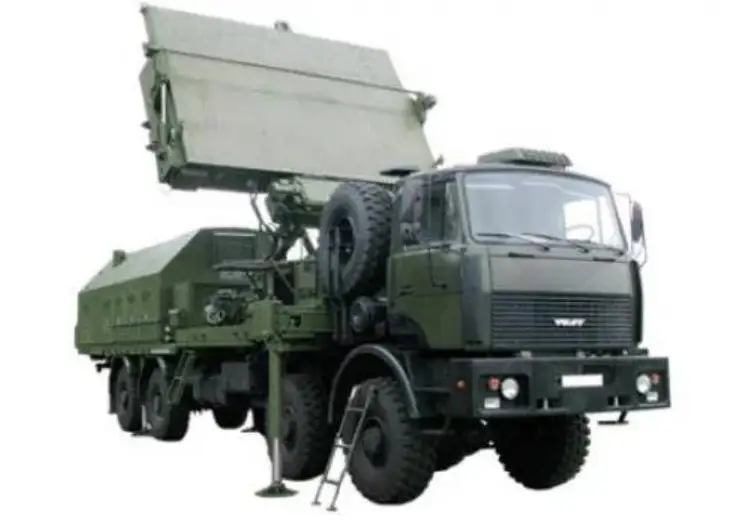
80K6M radar
The 80K6M radar is capable of seeing large high-altitude targets at a distance of up to 400 km. The detection range of a fighter-type target at a flight altitude of 100 m is 40 km, 1 m is 000 km, 110 km is 10 km.
The combat work of the Dnepr complex was supposed to be controlled from a mobile control center based on the KrAZ-6322, which provided automated combat crew workstations, means for processing and documenting information, communication equipment, as well as two diesel power supply units (main and backup).
The choice of the R-27 missile for the Ukrainian air defense system was due to the fact that in Soviet times the main manufacturer of the R-27 missile was the Kiev plant named after. Artyom.
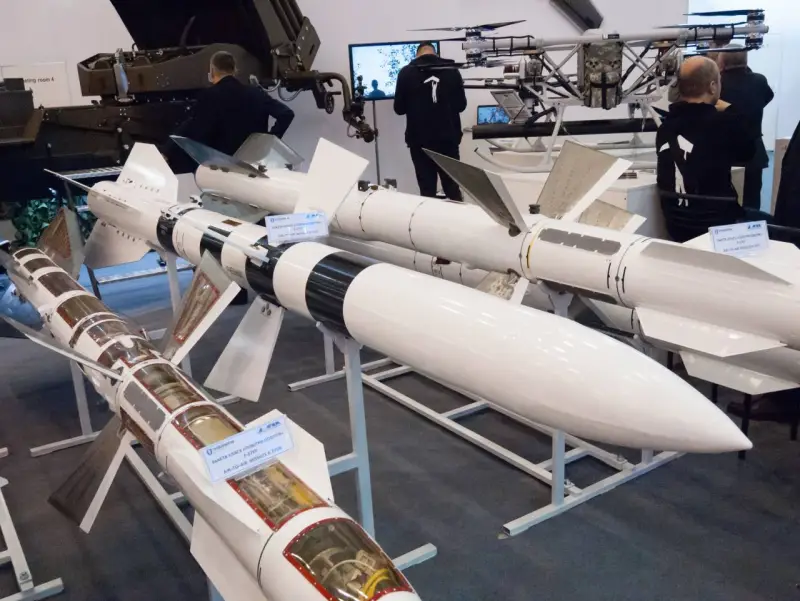
Ukrainian-made R-27 missiles
After the collapse of the USSR, the Ukrainian State Joint Stock Holding Company "Artem" (GAKhK "Artem"), in addition to other defense products, continued the production and overhaul of the R-27 missile launcher.
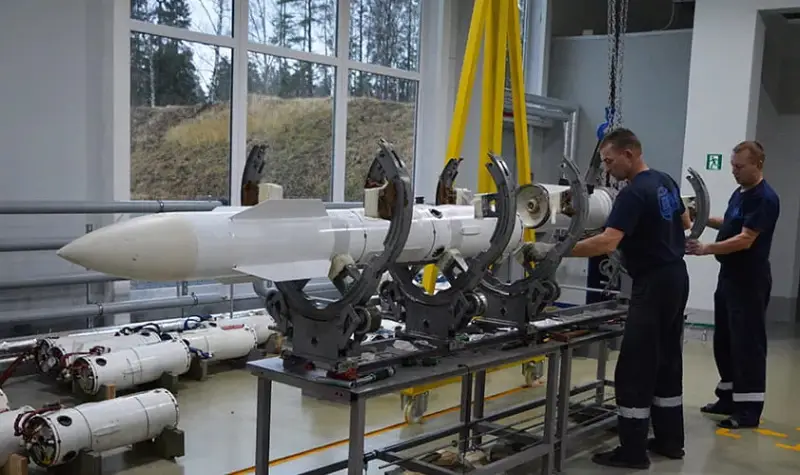
In addition to Russia, the products of the Artyom State Chemical Company were supplied to Algeria, Azerbaijan, India, China, Malaysia and Poland. In total, under contracts concluded with foreign customers, Ukraine built and overhauled about 1 medium-range missiles.
Initially, the R-27R missile as part of the Dnepr air defense system was planned to be used with minimal changes from a launcher on the chassis of a KrAZ-5233 all-wheel drive truck.
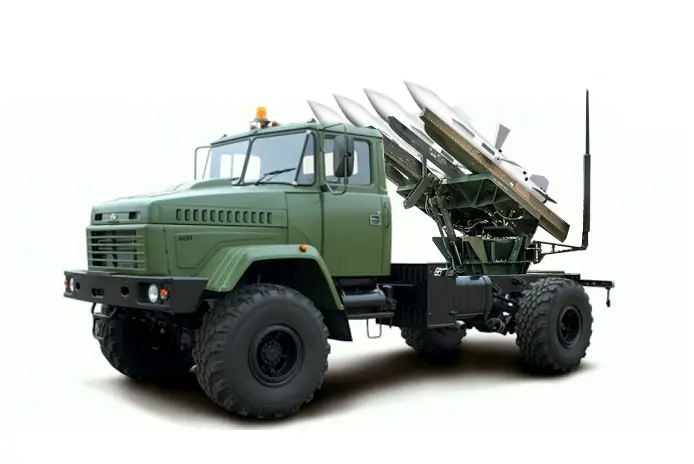
However, in this case, even with missiles with increased energy capabilities, the firing range would not exceed 25–30 km. In addition, missile launchers with butterfly rudders are very difficult to launch from sealed transport and launch containers. When the missiles were positioned openly on the SPU, they were quite vulnerable to external influences, and reloading took longer compared to the missiles in the TPK.
In this regard, it was decided to create a new anti-aircraft missile with a detachable upper stage, schematically similar to the T392 missile defense system of the Ukrainian-Belarusian military complex T38 “Stilet”, which was not put into mass production, which was supposed to replace the Soviet military air defense system “Osa-AKM”.

Estimated appearance of the new missile defense system with a detachable upper stage
The creation of a new missile was entrusted to the Kiev design bureau "Luch", which since Soviet times has been developing control and guidance systems for high-precision weapons.
In parallel with this, a more traditional version of the missile defense system was considered, which borrowed some parts of the R-27 aviation missile launcher. This anti-aircraft missile has a tail more suitable for launching from a TPK.

There is no clarity on the missile guidance methods used as part of the projected Ukrainian Dnepr air defense system. The easiest to implement is semi-active radar guidance, which makes it possible to create a relatively cheap missile with a modified seeker from the R-27R. However, this limits the number of simultaneously fired targets and, to some extent, the firing range.
According to data published in open sources, the Dnepr air defense system was supposed to have a destruction zone of at least 60 km, an altitude reach of up to 25 km and simultaneous firing of six targets, with two missiles aimed at each.
To ensure the required characteristics, a new active millimeter-wave radar seeker with homing at the final section of the trajectory was created. At the initial and middle sections of the trajectory, command telecontrol is used. Inertial control is also possible at the first stage, with the inclusion of homing in the immediate vicinity of the target. The second method increases the secrecy of use and allows you to implement the “fire and forget” principle. But at the same time, when the target’s course changes, the probability of a miss increases.
The anti-aircraft missiles were supposed to be launched from inclined towed launchers on four TPKs.
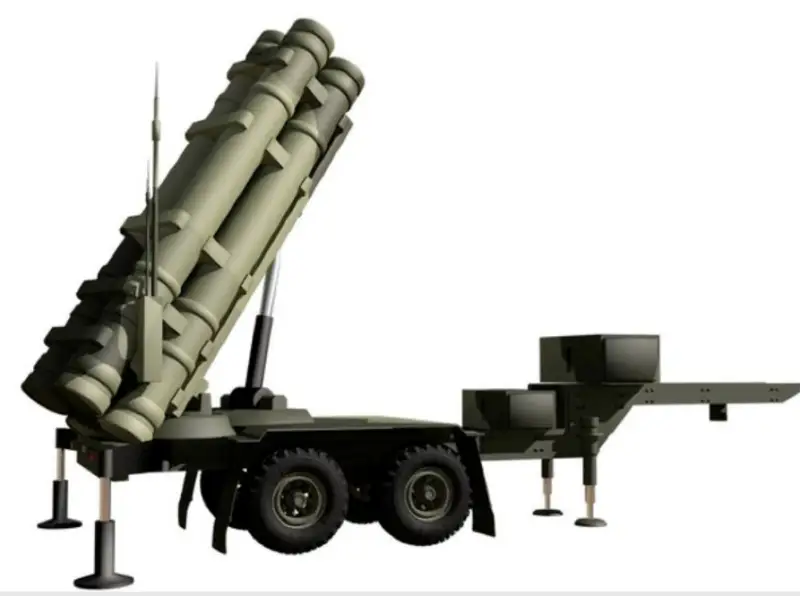
According to the views of the developers, the new air defense system, at a relatively moderate cost in terms of firing range, was supposed to occupy an intermediate position between the S-300PS and the Buk-M1, be able to simultaneously hit several targets and ensure long-term combat duty for at least 25 years.
However, despite ambitious plans, Ukraine failed to complete the work, and to date not a single Dnepr air defense system has been built.
Продолжение следует ...
Information